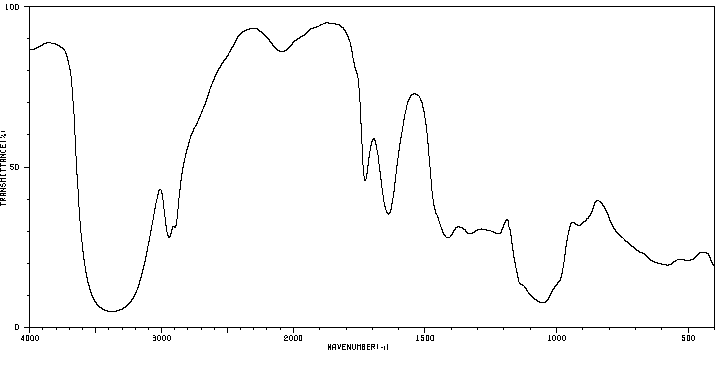(2R,3R)-2,3,4-三羟基丁醛 | 1758-51-6
中文名称
(2R,3R)-2,3,4-三羟基丁醛
中文别名
D-赤藓糖;D-(-)-赤藓糖;1,2,3-三羟基丁醛;D-赤丝藻糖;D(-)-赤藻糖
英文名称
D-erythrose
英文别名
erythrose;(2R,3R)-2,3,4-trihydroxybutanal
CAS
1758-51-6;583-50-6
化学式
C4H8O4
mdl
——
分子量
120.105
InChiKey
YTBSYETUWUMLBZ-IUYQGCFVSA-N
BEILSTEIN
——
EINECS
——
-
物化性质
-
计算性质
-
ADMET
-
安全信息
-
SDS
-
制备方法与用途
-
上下游信息
-
文献信息
-
表征谱图
-
同类化合物
-
相关功能分类
-
相关结构分类
物化性质
-
熔点:<25℃
-
比旋光度:D20 +1° -14.5° (3 days, c = 11)
-
沸点:144.07°C (rough estimate)
-
密度:1.0500 (rough estimate)
-
溶解度:溶于甲醇、水
计算性质
-
辛醇/水分配系数(LogP):-2.2
-
重原子数:8
-
可旋转键数:3
-
环数:0.0
-
sp3杂化的碳原子比例:0.75
-
拓扑面积:77.8
-
氢给体数:3
-
氢受体数:4
SDS
制备方法与用途
用途:用于制备生化试剂。
上下游信息
-
上游原料
中文名称 英文名称 CAS号 化学式 分子量 D-(-)-苏糖 D-threose 95-43-2 C4H8O4 120.105 阿拉伯糖 D-Arabinose 147-81-9 C5H10O5 150.131 D-核糖 D-ribose 50-69-1 C5H10O5 150.131 D-来苏糖 D-lyxose 1114-34-7 C5H10O5 150.131 -
下游产品
中文名称 英文名称 CAS号 化学式 分子量 D-(-)-苏糖 D-threose 95-43-2 C4H8O4 120.105 2,3,4-三羟基丁酸 D-erythronic acid 488-16-4 C4H8O5 136.105 —— D-threonic acid 20246-26-8 C4H8O5 136.105 D-阿拉伯糖-1-13C D-[1-(13)C]arabinose 70849-23-9 C5H10O5 151.12 D-核糖-1-13C D-(1-13C)-ribose 70849-24-0 C5H10O5 151.12 D-核糖 D-ribose 50-69-1 C5H10O5 150.131 2,4-二羟基-丁酸 2,4-dihydroxybutanoic acid 1518-62-3 C4H8O4 120.105
反应信息
-
作为反应物:描述:(2R,3R)-2,3,4-三羟基丁醛 在 sodium metabisulfite 、 sodium sulfite 作用下, 生成 3-磺酸基丙酸参考文献:名称:Hardell,H.-L.; Theander,O., Acta Chemica Scandinavica (1947), 1971, vol. 25, p. 877 - 882摘要:DOI:
-
作为产物:描述:参考文献:名称:用金属催化光氧化单糖。通过与金属离子的氧化-还原循环耦合进行的大气氧氧化摘要:在接近中性 pH 值范围内,在催化量的 FeCl3 存在下,通过 Pyrex 过滤光的照射,D-果糖被大气氧氧化降解为 D-赤藓糖醇。该反应通过与铁离子的氧化还原循环耦合进行。还发现 D-葡萄糖-FeCl3 和 D-果糖-MnCl2 系统对催化光氧化敏感。DOI:10.1246/cl.1984.267
文献信息
-
Multiple Forms of Xylose Reductase in <i>Candida intermedia</i>: Comparison of Their Functional Properties Using Quantitative Structure−Activity Relationships, Steady-State Kinetic Analysis, and pH Studies作者:Bernd Nidetzky、Kaspar Brüggler、Regina Kratzer、Peter MayrDOI:10.1021/jf034426j日期:2003.12.1The xylose-fermenting yeast Candida intermedia produces two isoforms of xylose reductase: one is NADPH-dependent (monospecific xylose reductase; msXR), and another is shown here to prefer NADH approximately 4-fold over NADPH (dual specific xylose reductase; dsXR). To compare the functional properties of the isozymes, a steady-state kinetic analysis for the reaction d-xylose + NAD(P)H + H(+) <--> xylitol木糖发酵酵母假丝酵母产生两种木糖还原酶同工型:一种是NADPH依赖性的(单特异性木糖还原酶; msXR),另一种是NADH优于NADPH(双特异性木糖还原酶; dsXR)的4倍。为了比较同工酶的功能特性,对反应中的d-木糖+ NAD(P)H + H(+)<->木糖醇+ NAD(P)(+)进行了稳态动力学分析,并进行了特异性分析测定一系列常数(k(cat)/ K(醛))的常数,以减少一系列侧链大小不同的醛的还原以及与酶的底物结合口袋的氢键结合能力。dsXR弱结合NAD(P)(+)(K(iNAD +)= 70 microM; K(iNADP +)= 55 microM)和NADH(K(i)= 8 microM)大约与NADPH(K(i)= 14 microM)。msXR显示NADPH和NADP(+)的均匀结合(K(iNADP +)大约为K(iNADPH)= 20 microM)。通过将dsXR的对数k(cat)/
-
Borate-Stabilized Transformation of C6 Aldose to C4 Aldose作者:Yueer Yan、Lei Feng、Gang Li、Shaoying Lin、Zhen Sun、Yahong Zhang、Yi TangDOI:10.1021/acscatal.7b01159日期:2017.7.7catalytic strategy to accumulate erythrose from C6 aldose in a highly selective manner via retro-aldol and aldol processes in alcohol solvent. In our proposed mechanism, borate can stabilize erythrose and avoid its further retro-aldol splitting or isomerization, and induce the production of erythrose again via the aldol condensation of the above-generated glycolaldehyde.
-
Kinetics of oxidation of monosaccharides with cerium(IV)作者:Pentti O.I. Virtanen、Raija Lindroos、Eija Oikarinen、Juhani VaskuriDOI:10.1016/0008-6215(87)80265-3日期:1987.9Abstract The kinetics of the oxidation of d -galactose, d -glucose, d -mannose, d -fructose, l -sorbose, l -arabinose, d -ribose, and d -xylose with cerium(IV) in perchloric acid were studied. Two complexes were found to form in each case. The first complex forms in a pre-quilibrium reaction during mixing in the stopped-flow apparatus. Michaelis-Menten kinetics were observed for this oxidation. The values
-
Conversion of sugars to ethylene glycol with nickel tungsten carbide in a fed-batch reactor: high productivity and reaction network elucidation作者:Roselinde Ooms、Michiel Dusselier、Jan A. Geboers、Beau Op de Beeck、Rick Verhaeven、Elena Gobechiya、Johan A. Martens、Andreas Redl、Bert F. SelsDOI:10.1039/c3gc41431k日期:——Bifunctional nickel tungsten carbide catalysis was used for the conversion of aqueous sugar solutions into short-chain polyols such as ethylene glycol. It is shown that very concentrated sugar solutions, viz. up to 0.2 kg L−1, can be converted without loss of ethylene glycol selectivity by gradually feeding the sugar solution. Detailed investigation of the reaction network shows that, under the applied reaction conditions, glucose is converted via a retro-aldol reaction into glycol aldehyde, which is further transformed into ethylene glycol by hydrogenation. The main byproducts are sorbitol, erythritol, glycerol and 1,2-propanediol. They are formed through a series of unwanted side reactions including hydrogenation, isomerisation, hydrogenolysis and dehydration. Hydrogenolysis of sorbitol is only a minor source of ethylene glycol. To assess the relevance of the fed-batch system in biomass conversions, both the influence of the catalyst composition and the reactor setup parameters like temperature, pressure and glucose addition rate were optimized, culminating in ethylene glycol yields up to 66% and separately, volume productivities of nearly 300 gEG L−1 h−1.双功能镍钨碳化物催化剂用于将水溶性糖溶液转化为乙二醇等短链多元醇。结果表明,通过逐渐加入糖溶液,可以转化非常高浓度的糖溶液(高达0.2 kg/L),而不会损失乙二醇的选择性。详细研究反应网络显示,在应用的反应条件下,葡萄糖通过逆醛醇反应转化为甘油醛,甘油醛进一步通过氢化反应转化为乙二醇。主要副产物是山梨醇、赤藓糖醇、甘油和1,2-丙二醇。它们是通过一系列不希望的副反应(包括氢化、异构化、氢解和脱水)形成的。山梨醇的氢解只是乙二醇的次要来源。为了评估批量进料系统在生物质转化中的相关性,优化了催化剂组成和反应器设置参数(如温度、压力和葡萄糖添加速率),最终乙二醇的收率高达66%,体积产率接近300 gEG/L/h。
-
Catalysis and Stability Effect of Solvent Alcohol on the C6 Aldose Conversion toward Tetrose作者:Wenrong Hou、Yueer Yan、Gang Li、Yulu Zhan、Lei Feng、Ruohong Zhang、Zhen Hua Li、Yahong Zhang、Yi TangDOI:10.1002/cctc.201900094日期:2019.8.21of biomass‐derived platform chemicals via a selective C−C splitting. Herein, we describe a solvent‐catalysed strategy to high‐selectively accumulate tetrose (four‐carbon platform chemical) from C6 aldoses via the retro‐aldol/aldol process. We find that alcohol solvents with Lewis acidity facilitate the C−C splitting process of hexose under the catalyst‐free condition. The conversion is the fastest in将生物质原料转化为各种有价值的化学物质具有重要意义。作为一种典型的途径,单糖的逆醛醇缩合通过选择性的C-C裂解大大扩展了源自生物质的平台化学物质的种类。本文中,我们描述了一种溶剂催化策略,可通过逆醛醇/醛醇缩合工艺从C6醛糖中高选择性地积累四氯化碳(四碳平台化学品)。我们发现具有路易斯酸度的醇溶剂可在无催化剂条件下促进己糖的CC裂解过程。在甲醇中转化最快,而在异丙醇中转化最慢。通过改变蔗糖和乙醇醛(GA)之间的平衡,醇极大地影响了产品分布。加入催化剂只会加快反应速度,并且不会更改产品分配。一方面,GA用甲醇或乙醇的缩醛化作用使平衡状态从蔗糖向GA转移,这导致在甲醇或乙醇溶剂中蔗糖的收率低。另一方面,在异丙醇或正丁醇中可以很容易地积累蔗糖,而异丙醇中的蔗糖产率要比在正丁醇中的高,因为它可以很好地溶剂化和稳定化蔗糖。这种依赖溶剂的反应策略提供了一种新的可能性,它通过利用溶剂化作用,有助于将生物
表征谱图
-
氢谱1HNMR
-
质谱MS
-
碳谱13CNMR
-
红外IR
-
拉曼Raman
-
峰位数据
-
峰位匹配
-
表征信息
同类化合物
(反式)-4-壬烯醛
(s)-2,3-二羟基丙酸甲酯
([1-(甲氧基甲基)-1H-1,2,4-三唑-5-基](苯基)甲酮)
(Z)-4-辛烯醛
(S)-氨基甲酸酯β-D-O-葡糖醛酸
(S)-3-(((2,2-二氟-1-羟基-7-(甲基磺酰基)-2,3-二氢-1H-茚满-4-基)氧基)-5-氟苄腈
(R)-氨基甲酸酯β-D-O-葡糖醛酸
(5,5-二甲基-2-(哌啶-2-基)环己烷-1,3-二酮)
(2,5-二氟苯基)-4-哌啶基-甲酮
龙胆苦苷
龙胆二糖甲乙酮氰醇(P)
龙胆二糖丙酮氰醇(P)
龙胆三糖
龙涎酮
齐罗硅酮
齐留通beta-D-葡糖苷酸
鼠李糖
黑芥子苷单钾盐
黑海棉酸钠盐
黑木金合欢素
黑曲霉三糖
黑介子苷
黄尿酸8-O-葡糖苷
麻西那霉素II
麦迪霉素
麦芽糖脎
麦芽糖基海藻糖
麦芽糖1-磷酸酯
麦芽糖
麦芽四糖醇
麦芽四糖
麦芽十糖
麦芽六糖
麦芽五糖水合物
麦芽五糖
麦芽五糖
麦芽五糖
麦芽三糖醇
麦芽三糖
麦芽三糖
麦芽三塘水合
麦芽七糖水合物
麦芽七糖
麦法朵
麦可酚酸-酰基-Β-D-葡糖苷酸
麦利查咪
麝香酮
鹤草酚
鸢尾酚酮 3-C-beta-D-吡喃葡萄糖苷
鸡矢藤苷







